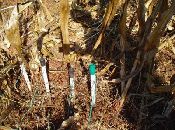| Evaluation of land management practices and techniques using indicators |
 |
|
The comparative analysis of the study sites elicited a number of indicators that are directly or indirectly related to different degradation processes. However, the large number of these (50 in the case of water stress) makes the use of all of them impractical. Further statistical analysis of the data, from all the DESIRE study sites, was used to reduce the lists to a smaller number of effective indicators.
The coefficients of linear regression between each degradation process and indicator values have been used to develop algorithms for calculating a desertification risk index (DRI). For example, when the main cause of degradation is water stress,
All the algorithms have been included in a decision support system the Desertification Risk Assessment Tool which has been designed for use by various stakeholders so they can assess land degradation and desertification risk under existing physical environmental, economic and social conditions and select the appropriate land management practices and techniques for combating the risk.
|
|||||||||||||||||||||||||||||||||||||

Acknowledgement
The DESIRE project was
|
DESIRE brought together the expertise of
26 international research institutes
and non-governmental organisations.
This website does not necessarily
represent the opinion of the
European Commission. The European
Commission is not responsible for
any use that might be made of the
information contained herein. 


